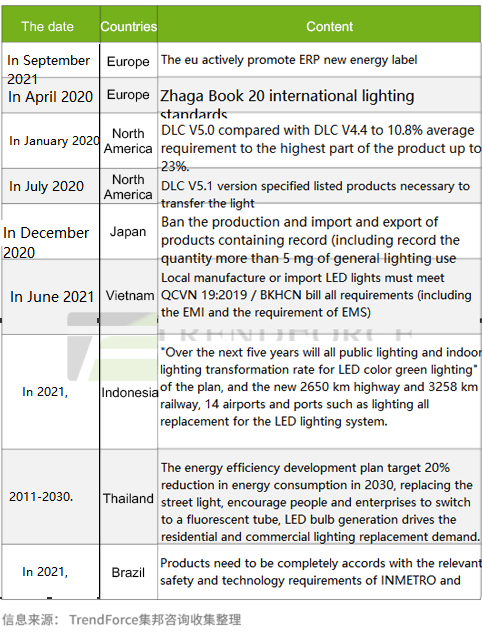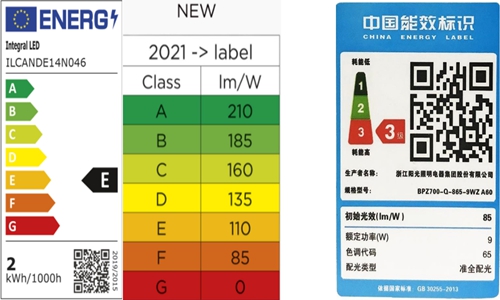2022-04-01
"Green Power"
The concept of "green lighting" was proposed by the US National Environmental Protection Agency in the early 1990s. It includes four indicators of high efficiency, energy saving, environmental protection, safety and comfort. High-efficiency and energy-saving, as the name implies, ensures that the least amount of electric energy is consumed under the condition of sufficient lighting, thereby reducing the pollutant discharge of the power plant and achieving the purpose of environmental protection. The light is clear and soft and does not produce ultraviolet rays, and the anti-halation and light pollution are for the purpose of safety and comfort.
From a macro perspective, the specific implementation of green electricity consumption can be divided into two aspects: reducing energy consumption on the one hand, and developing new technologies and products on the other hand. Replacing incandescent lamps with LEDs nationwide can save about 41.67Mtce (2018), which shows that its energy saving effect is remarkable. With the development of technology, today's LED lighting has developed to the late stage of maturity, and it is inevitable to develop new applications, such as the cross-industry combination of smart lighting, such as the combination of lighting systems and big data in different application scenarios.
From a microscopic perspective, the speed at which an enterprise eliminates old production capacity, develops new energy-saving products, and the feasibility of long-term goals determines its future development. With the continuous advancement of technology and the ever-changing market, for the lighting industry, it is easy to be eliminated by the times if it sticks to the rules and does not cut the meat in time or even pay attention to the changes in market expectations. Speed is efficiency, and sometimes it is the key to winning. This requires companies to keep abreast of the world situation and the government's industrial planning, so as to make timely or even advanced decision-making adjustments.
Countries from the policy to promote green lighting
After the outbreak of the epidemic, various countries actively promoted green lighting plans, and most countries have formulated rigid laws and regulations and target completion standards. Typical of these are the downgrading of energy labels and the transparency of product information implemented in Europe, China and some other countries. The downgrading of energy labels avoids the appearance of confusing labels such as "AA", "AAA" and "5A" in the past due to technological development. The same QR code is more convenient for users and other related industries to fully understand product information, so that product informatization makes consumers more independent and selective. Secondly, a comprehensive ban on products and materials with serious toxic and harmful pollution, such as Japan's ban on import and export of mercury-containing products.

 Image source: European Commission, China Energy Efficiency Labeling Network
Image source: European Commission, China Energy Efficiency Labeling Network
The impact of "green lighting" on the LED lighting industry can be viewed from four aspects: raw materials, equipment, technology, and changes or expansion of application scenarios.
"Green Lighting" Influences Future Material and Equipment Choices
Common substrate materials include gallium nitride substrates, silicon substrates and sapphire substrates. In June 2011, China's first super 100kg sapphire crystal became one of the mainstream substrate materials after it came out in Yangzhong, Jiangsu. At present, sapphire substrate accounts for 20% of the production cost of epitaxial wafers. Sapphire's competitor, silicon, has better thermal conductivity and a larger light-emitting area.
From the perspective of energy-saving and high-efficiency requirements, the selection of raw materials in the future is more inclined to have higher luminous efficiency, controllable lighting brightness, and short product replacement frequency. Therefore, silicon substrates and even silicon carbide substrates will be the strong opponents of sapphire substrates in the upstream LED lighting industry after the cost problem is solved in the future.
At present, the mainstream chip equipment in the world is MOCVD. The main manufacturers are AIXTRON in Germany, Veeco in the United States, and China Microelectronics Corporation. Since 2009, governments across mainland China have subsidized the purchase of MOCVD equipment by LED chip manufacturers. Subsequently, a large number of LED chip companies have increased their demand for MOCVD equipment.
According to the statistics of LEDinside, the optoelectronic research division of TrendForce, by the end of 2012, the number of MOCVD equipment in China had exceeded 900, and from 2015 to 2019, the global MOCVD equipment market scale showed a rapid growth trend, and the global LED chip production capacity gradually increased to mainland China. Regional transfer, at this stage, China has become the world's largest LED chip manufacturer.
The impact of "green lighting" on technology
Policies correct the direction of the industry, and technology promotes the development of the industry. The rise of IOT and 5G networks has driven LED lighting to the digital technology field of cross-industry integration. The wide application of sensors and the cloudification of big data make intelligent systems become the development focus of downstream enterprises in recent years. In the digital age, the application of 5G networks and sensors can analyze user information, product usage environment, and user behavior. By setting up intelligent systems, lighting is more efficient and humanized, and unnecessary energy consumption is also saved. .
In addition, the government's vigorous promotion of smart cities and smart engineering projects will increase the market demand for smart lighting. In 2017, the global smart lighting market entered a stage of rapid development, with a market size of nearly US$4.6 billion. TrendForce estimates that the global smart lighting market will reach US$8.19 billion in 2022.
The impact of "green lighting" on application scenarios
Smart Lighting
With the acceleration of urbanization, the demand and construction scale of urban public lighting facilities are increasing year by year, and the energy consumption of urban public lighting is also increasing. In the era of sustainable energy development, energy saving and emission reduction, efficient lighting, improving the life of street lamps and other outdoor lighting, and reducing maintenance and management costs are also the main needs of urban intelligence.
For example, in terms of traffic lighting, the smart lighting system can adjust the brightness of the street lights according to the real-time traffic flow and the driving direction of the vehicles as long as there are vehicles on the road under video surveillance, and can freely group and control the street lights. After testing, the power saving rate can reach 80.5%. .
Plant Lighting
With the continuous deterioration of the earth's living environment, and energy conservation and emission reduction in agriculture, the plant lighting that simulates sunlight has shown explosive growth in recent years, and the industry's attention has gradually increased. Although the main driving factor is the rapid growth of the North American medical and recreational cannabis market, in the long run, LED lighting applications in the fields of vegetables, medicinal materials and other fields have much more application space than cannabis.
According to the latest research data from TrendForce, the global LED plant lighting market will grow by 10.4% to US$1.85 billion in 2022. In the first half of last year, the development of the plant lighting market slowed down, mainly due to the delay in shipping and the increase in freight prices affected by the epidemic, followed by the shortage of power ICs and other political factors.
"Green Lighting" promotes cross-industry cooperation, and enterprises actively deploy the field of smart lighting
Enterprises actively promote green smart lighting, optimize resource allocation and expand business scale through cooperation. In the fiercely competitive market environment, they can quickly achieve expected goals and gain competitive advantages. At the same time, with the help of partners' resources and advantages, they can quickly deploy emerging application scenarios and Connect related industry chains.
(Text: LEDinside Hannah)